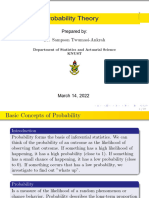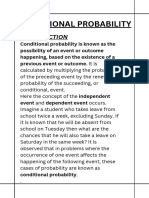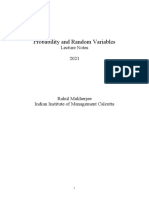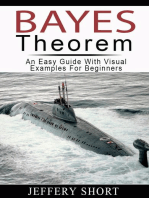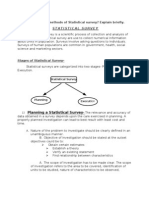0 ratings0% found this document useful (0 votes)
749 viewsConditional Probability
Conditional probability is the probability of an event A occurring given that another event B has occurred. It is written as P(A|B) and refers to the probability of A under the condition that B is known to have occurred. An example is calculating the probability that one die shows a 3 given that the sum of the dice is 9. The sample space is reduced to only those outcomes where the sum is 9. The probability is then calculated as the number of outcomes where one die is 3 (2 outcomes) divided by the total number of outcomes where the sum is 9 (4 outcomes), which equals 1/2.
Uploaded by
shaileshCopyright
© Attribution Non-Commercial (BY-NC)
Available Formats
Download as DOCX, PDF, TXT or read online on Scribd
0 ratings0% found this document useful (0 votes)
749 viewsConditional Probability
Conditional probability is the probability of an event A occurring given that another event B has occurred. It is written as P(A|B) and refers to the probability of A under the condition that B is known to have occurred. An example is calculating the probability that one die shows a 3 given that the sum of the dice is 9. The sample space is reduced to only those outcomes where the sum is 9. The probability is then calculated as the number of outcomes where one die is 3 (2 outcomes) divided by the total number of outcomes where the sum is 9 (4 outcomes), which equals 1/2.
Uploaded by
shaileshCopyright
© Attribution Non-Commercial (BY-NC)
Available Formats
Download as DOCX, PDF, TXT or read online on Scribd
You are on page 1/ 1
Q. 5 What is conditional probability? Explain with an example.
Ans. CONDITIONAL PROBABILITY
Conditional probability is the probability of some event A, given the
occurrence of some other event B. Conditional probability is written P(A|B),
and is read "the (conditional) probability of A, given B" or "the probability of
A under the condition B". When in a random experiment the event B is
known to have occurred, the possible outcomes of the experiment are
reduced to B, and hence the probability of the occurrence of A is changed
from the unconditional probability into the conditional probability given B.
Two events A and B are said to be dependent when B can occur only
when A is known to have occurred or vice versa. The probabilities associated
with such event are called conditional probabilities.
The probabilities of the occurrence of the event A when the event B has
already occurred is called the conditional probability of occurrence of A given
that the event B has already occurrence and is denoted by P(A/B).
Example:- A pair of dice is rolled. If the sum of 9 has appeared, find the
probability that one of the dice shows 3.
Solution:- The equiprobable sample space consisting of 36 sample points.
The event A = The sum of the scores is 9 has four sample points (6,3), (5,4),
(4,5), (3,6), and its reduced sample space.
Under the assumption that A has happened, the event B = one of the dice
shows 3 has only two sample points, that is (B∩A) = [(3,6),(6,3)].
∴ P(B/A) = 2/4 = 1/2
Also using the formula derived above, we get P(B/A) = P(A∩B)P(A)
∴PA∩B= n(A∩B)n(S)=236, and PA= n(A)n(S)= 436
=2/364/36=24= 1/2
You might also like
- AP Statistics Chapter 5 - Probability: What Are The Chances? 5.1: Randomness, Probability and SimulationNo ratings yetAP Statistics Chapter 5 - Probability: What Are The Chances? 5.1: Randomness, Probability and Simulation3 pages
- Read ... The Probability of B Given A.: Example 1: A Bag Contains 12 Red M&MS, 12 Blue M&MS, and 12 GreenNo ratings yetRead ... The Probability of B Given A.: Example 1: A Bag Contains 12 Red M&MS, 12 Blue M&MS, and 12 Green5 pages
- 3A - Conditional Probablility and IndependenceNo ratings yet3A - Conditional Probablility and Independence17 pages
- Statistics For Business Economics Prob Theory Unit 2 (A)No ratings yetStatistics For Business Economics Prob Theory Unit 2 (A)79 pages
- Conditional Probability: Lecture Notes-2No ratings yetConditional Probability: Lecture Notes-21 page
- Chapter 2. Discrete Models: 1 Probability - The Foundation of StatisticsNo ratings yetChapter 2. Discrete Models: 1 Probability - The Foundation of Statistics29 pages
- Probability and Statistical Analysis: Chapter FiveNo ratings yetProbability and Statistical Analysis: Chapter Five25 pages
- 25-27 Statistical Reasoning-Probablistic Model-Naive Bayes ClassifierNo ratings yet25-27 Statistical Reasoning-Probablistic Model-Naive Bayes Classifier35 pages
- Evans - Analytics2e - PPT - 05 Data Modelling100% (2)Evans - Analytics2e - PPT - 05 Data Modelling98 pages
- PPT01 - Introduction To Probability TheoryNo ratings yetPPT01 - Introduction To Probability Theory32 pages
- MBA HRD II SEM 206 Multiplication_Theorem_on_Probability-convertedNo ratings yetMBA HRD II SEM 206 Multiplication_Theorem_on_Probability-converted4 pages
- 7.introduction To Artificial IntelligenceNo ratings yet7.introduction To Artificial Intelligence25 pages
- Lecture 7 - Statistics and Data Analysis I 2No ratings yetLecture 7 - Statistics and Data Analysis I 22 pages
- Practical Data Science: Basic Concepts of ProbabilityNo ratings yetPractical Data Science: Basic Concepts of Probability5 pages
- Schaum's Easy Outline of Probability and Statistics, Revised EditionFrom EverandSchaum's Easy Outline of Probability and Statistics, Revised EditionNo ratings yet
- Q.4 List and Explain Five Important Principles of Business Report Writing. AnsNo ratings yetQ.4 List and Explain Five Important Principles of Business Report Writing. Ans2 pages




























